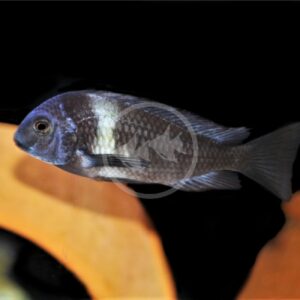Cichlids
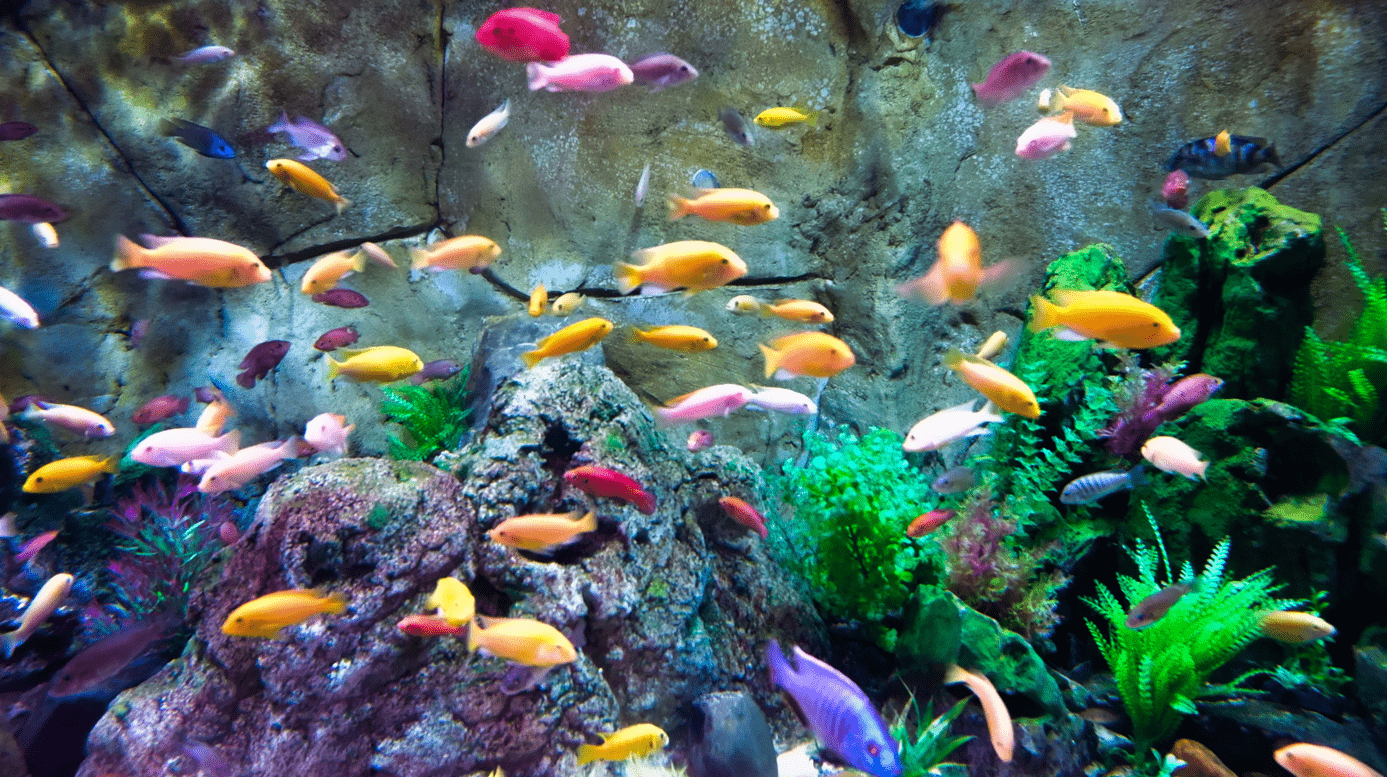
Cichlid is a nondescript term for members of the family Cichlidae, with nearly 1,300 species identified from Angelfish to Oscars. This Blog post aims to provide a general overview about the three groups of cichlids we carry: African, South American, and Central American. Please realize that this information is very broad, and there are certainly exceptions to the rule in each group. Mixing cichlids from these different regions is highly variable. We encourage you to use this post as a reference to spark ideas, but to talk over your options with an Aquatics Unlimited employee.
SOUTH AMERICAN CICHLIDS
South American Cichlids are primarily made up of more docile cichlids with great diversity in size, color and body shape. Angelfish, Oscars, German Blue Rams, Severums, Discus, Apistogrammas, Acaras, Jurupari and Geophagus are some examples.
Cichlids in this group are often kept in active community-type aquariums due to their more laid back nature. This group is carnivorous or omnivorous, and should be provided with a variety of high quality protein based and vegetable based staple and frozen foods.
As true with all cichlids, they can still have territory disputes, but most of the time it is focused on the same species. If there are other cichlids in the tank that do not resemble them, they often go ignored. Some South American cichlids will eat smaller community type fish, so choose tank mates accordingly.
Exceptions that are more aggressive: Green Terror & Red Terror.

ANGELFISH – FW SILVER
Pterophyllum scalare
Price range: $9.99 through $39.99
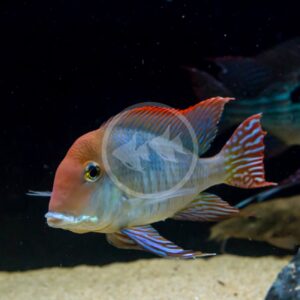
CICHLID – GEOPHAGUS TAPAJOS RED HEAD
Geophagus pyrocephalus
Price range: $19.99 through $69.99

CICHLID – GREEN TERROR
Andinoacara rivulatus
Price range: $14.99 through $129.99
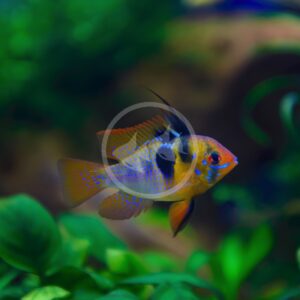
CICHLID – RAM GERMAN BLUE
Mikrogeophagus ramirezi
Price range: $12.99 through $24.99
AFRICAN CICHLIDS
African Cichlids we carry come from two main lakes, Tanganyika and Malawi. Occasionally, we carry Obliquidens from Lake Victoria. Malawi cichlids tend to be more robust and have higher endurance, while Tanganyikan cichlids are overall more mellow (with the exception of tropheus). At any rate, African cichlids tend to have the greatest rivalry for prime real estate in the aquarium.
Most individuals in this group do not get very large. Adult sizes tend to range between 4”- 8”. This group is predominantly herbivorous, or omnivorous. They should regularly be fed a mixed diet of high quality vegetable, spirulina and protein based foods. Successful African tanks are heavily stocked. The reason being is that this spreads out aggression, and a dominant fish is less likely to overly antagonize weaker individuals. With too few individuals, aggression may be more apparent (torn fins, hiding or nervous fish) and it may be more difficult to introduce new additions. Mixing cichlids from both lakes is variable.
Common Lake Malawi Cichlids: Yellow Labs, Cobalt Blue, Red Zebra, Venustus, Peacocks, Haps, Bumblebee, Auratus, Electric Blue Johanni, Acei, Afra, Demasoni and Kenyi.
Common Lake Tanganyika Cichlids: *Tropheus, Calvus’, Compressiceps, Shelldwellers, Julidochromis, Brichardi, Ventralis and Frontosa.
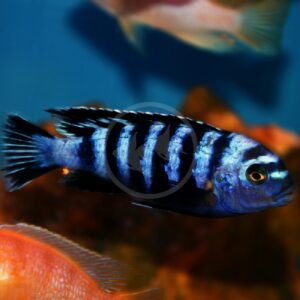
CICHLID – DEMASONI
Chindongo demasoni
Price range: $9.99 through $24.99

CICHLID – HAP BLUE DOLPHIN
Cyrtocara moorii
Price range: $12.99 through $19.99
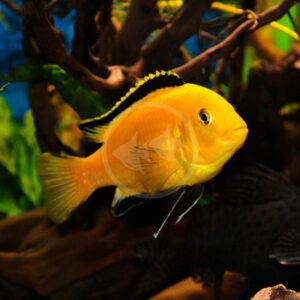
CICHLID – LAB YELLOW
Labidochromis caeruleus
Price range: $5.99 through $19.99
CICHLID – TROPHEUS DUBOISI
Tropheus duboisi
Price range: $22.99 through $34.99
CENTRAL AMERICAN CICHLIDS
Central American Cichlids are known for being the largest and most aggressive cichlids in the Hobby. Common Central American cichlids include: Managuense, Red Devil, Dovi, Cuban, Wolf & Texas. Their average adult size is approximately 12”.
Some of these species are so aggressive and relentless that even being kept with other fish of similar temperament could mean that they may fight to the death. The majority of their aggression is for their immediate space (i.e., the aquarium is too small). We would recommend starting with no smaller than a 75 gallon aquarium, with 1 C.A. cichlid per 25 gallons of water (in order to accommodate them long-term). One of the best ways to help ensure compatibility is to grow the fish up together. Juvenile or more immature specimens tend to be less territorial than adults, also. As they mature, they attain a better idea of how to handle themselves with their fellow tank mates. Inevitably, it may end up being best to keep a singular large Central American cichlid in the aquarium.
As predominantly carnivores, you may be compelled to feed these cichlids live food. We would suggest keeping that to a minimum or avoid altogether. Live foods are not very nutritionally dense, can cause more aggressive behavior and increase the chance of disease (Ich) being introduced into your aquarium. There are plenty of options of larger pellet, flake, and/or frozen food varieties to offer your Central American cichlids.
Exceptions that aren’t as aggressive: Jack Dempsey, Convict (except when spawning), Firemouth, Vieja and Rainbow cichlid.
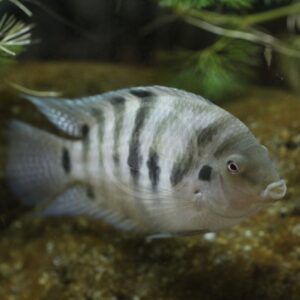
CICHLID – CONVICT
Amatitlania nigrofasciata
Price range: $1.99 through $24.99

CICHLID – FIREMOUTH
Thorichthys meeki
Price range: $7.99 through $49.99
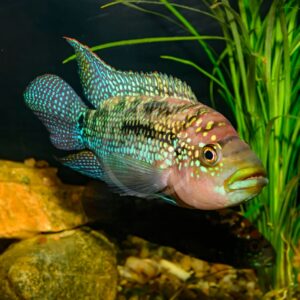
CICHLID – JACK DEMPSEY
Rocio octofasciata
Price range: $9.99 through $69.99
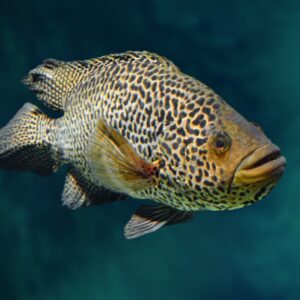
CICHLID – JAGUAR / MANAGUENSE
Parachromis managuensis
Price range: $6.49 through $79.99

